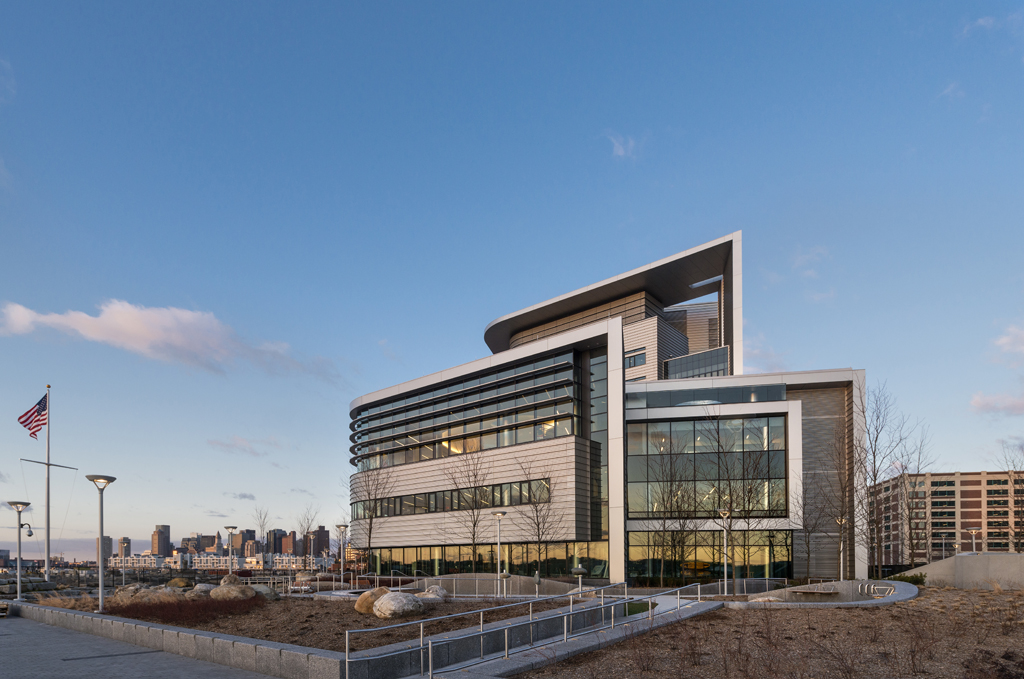Perkins+Will Defines Inclusive Design at New Spaulding Rehabilitation Hospital
 Perkins+Will recently unveiled the new 262,000-square-foot Spaulding Rehabilitation Hospital. The design process, led by Ralph Johnson and managed by Perkins+Will’s Boston office, resulted in a state-of-the-art healthcare resource for patients, families and the community at large. The Charlestown facility expands the offerings of the current 42-year-old hospital and features 132 private patient rooms, large common areas open to the community and a thoughtful design that promotes wellness for people with disabilities.
Perkins+Will recently unveiled the new 262,000-square-foot Spaulding Rehabilitation Hospital. The design process, led by Ralph Johnson and managed by Perkins+Will’s Boston office, resulted in a state-of-the-art healthcare resource for patients, families and the community at large. The Charlestown facility expands the offerings of the current 42-year-old hospital and features 132 private patient rooms, large common areas open to the community and a thoughtful design that promotes wellness for people with disabilities.
“The vision for the new Spaulding Rehabilitation Hospital was to create a space for patients that promotes healing and addresses the needs of the widest possible audience,” said Ralph Johnson, FAIA, LEED AP, design director at Perkins+Will. “What resulted is a building design that is transparent and carefully researched.”
Located on a remediated brownfield parcel in the Charlestown Navy Yard, the building is a new gathering place for the community – dedicating 75 percent of the first floor to public use and integrating with the Boston HarborWalk. Once part of a timber receiving basin, the landscape design incorporates reclaimed timbers throughout the site and takes full advantage of waterfront views of the Boston skyline. A trail running along the waterfront features therapeutic equipment and offers patients the opportunity to encourage the healing process by performing physical therapy on a variety of different landscaped surfaces.
Tied to the site’s naval yard history, the gray materials of the façade are reminiscent of the military battleships and aircraft carriers berthed at the yard for much of the 20th century. The scale of the building is visually reduced by dividing the structure into two connected sections – an eight-story patient tower and a three-story therapeutic gymnasium and pool. The building can be viewed from all sides – there is no back. Each section of the divided structure utilizes a variety of materials to create visual interest and reveal a slightly different building from each angle. Glass curtainwall is generously integrated into the design, creating transparency and an abundance of natural light throughout the interior, resulting in an atmosphere that is open and inviting.
The new Spaulding Rehabilitation Hospital incorporates inclusive design into every aspect of the facility. Perkins+Will’s design team was dedicated to researching and testing each component of the design so that the building addresses the needs of the widest possible audience, irrespective of ability. The team worked with accessibility experts and conducted extensive research on their own to create a hospital of the future, one that went beyond only meeting ADA requirements. Every aspect of the building design has been considered – the entry is at street level; the reception desk is low and rounded; the patient rooms have custom cabinetry and automated shades, patient lifts, private bathrooms and amenities such as private refrigerators, sleeping accommodations for family members and a wireless connection for patients and guests. The building program includes outpatient services, a pool for aquatherapy, two large gymnasiums, an activities-of-daily-living suite, transitional patient apartment and satellite gyms embedded on two inpatient floors.
“For far too long, rehabilitative care was an afterthought to many, relegated to the basements of hospitals and out of sight. This hospital makes a bold statement that a new era of rehabilitative medicine is hereby bringing together scientific innovation and patient-centered design that puts this institution on par with the major centers of healing in the world,” said David Storto, president, Spaulding Rehabilitation Hospital. “It’s truly an honor to lead Spaulding and serve this region with its leaders who have the forethought to understand how vital Spaulding will be for decades to come.”
Led by Perkins+Will’s Global Sustainable Healthcare Leader, Robin Guenther, resiliency planning and sustainable design were also a key part of the design process. In response to climate change and probable rising sea levels, the main floor was raised one foot and all of the HVAC equipment was located on the roof. Gymnasiums, multi-purpose rooms and educational rooms utilize automatic operable windows for natural ventilation. Operable windows allow the building to remain operational even if mechanical systems are interrupted. Vegetated roofs mitigate storm water runoff and reduce cooling loads and heat-island effect. Therapeutic terraces on the third and fourth floors serve as places of respite for patients, staff and families. Gardens and views of Boston Harbor provide further uplifting diversions to the occupants. The project has achieved LEED-Gold certification.
“Beyond the energy performance and safety features of the design, we emphasized the importance of creating a healthy healing environment for patients,” said Robin Guenther, FAIA, LEED AP, principal. “We designed a human-centered patient experience — focused on restoration and health — that provides patients, families and staff a supportive, sustainable environment to improve rehabilitation results.”
Posted April 24, 2013
More Articles:
- Coverings 2024
Apr 22, 2024 – Apr 25, 2024 - Hospital, Outpatient Facilities & Medical Office Buildings Summit
Apr 25, 2024 – Apr 25, 2024 - CxA Workshop & Exam
Apr 29, 2024 – Apr 30, 2024 - EMP Seminar & Exam at CxEnergy 2024
Apr 29, 2024 – Apr 30, 2024 - CxEnergy
Apr 29, 2024 – May 2, 2024 - PHCC West 2024
Apr 29, 2024 – May 2, 2024 - Lean in Design Forum 2024
May 1, 2024 – May 2, 2024











